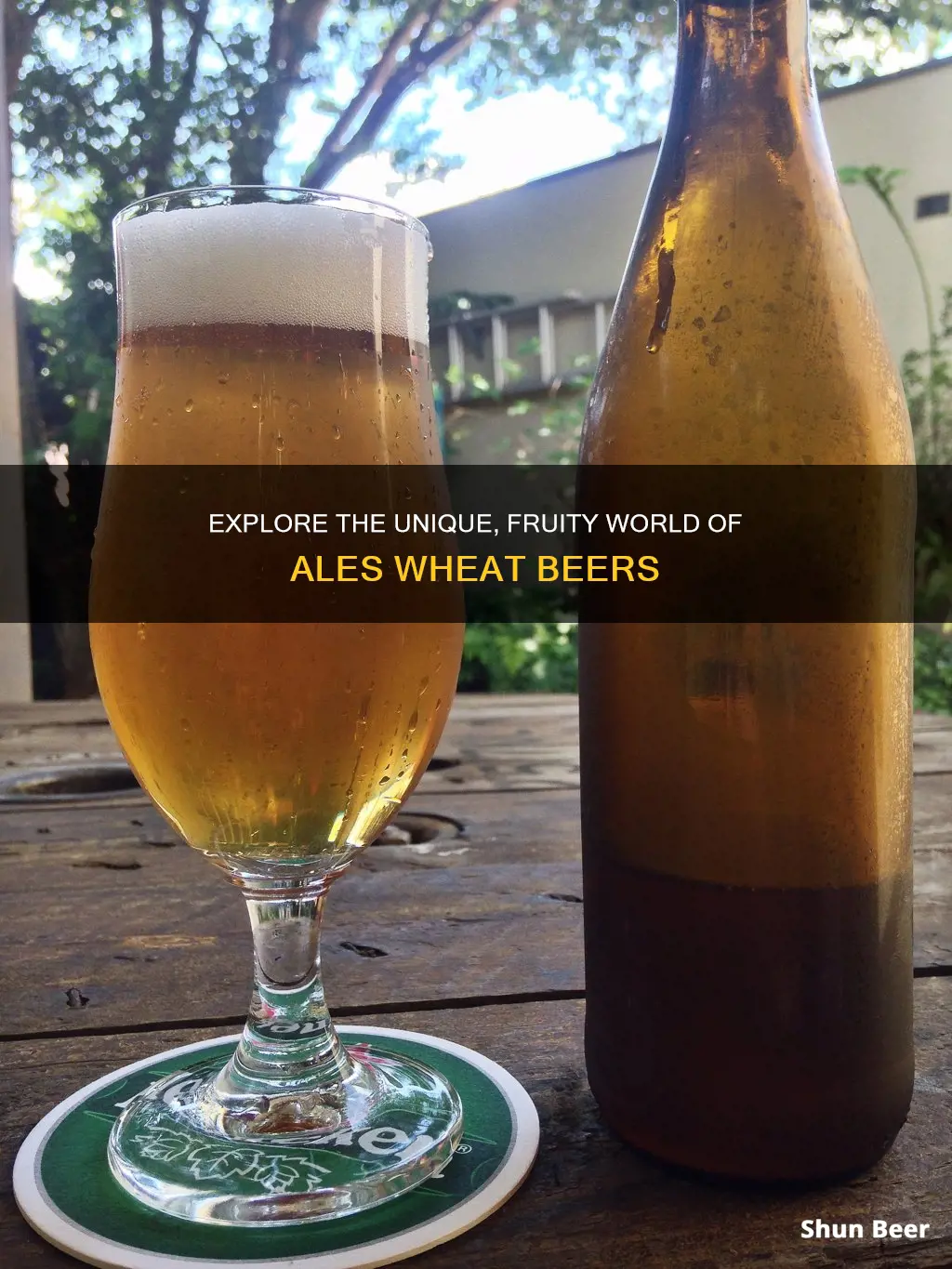
Wheat beers are top-fermented ales, not lagers. They are brewed with a large proportion of wheat—at least 50%—compared to the amount of malted barley. Wheat beers are light, summery, and refreshing, with a tangy flavour that combines well with fruit. The two main varieties are German Weizenbier and Belgian Witbier, but other types include Lambic, Berliner Weisse, and Gose.
| Characteristics | Values |
|---|---|
| Fermentation | Top-fermented |
| Ingredients | Brewed with a large proportion of wheat relative to the amount of malted barley |
| Flavour | Tangy, fruity, spicy, bready, bright, lemony, banana, clove, bubblegum, coriander, citrus |
| Appearance | Cloudy, clear, amber, mahogany, hazy, pale, light |
| Texture | Creamy, silky, effervescent |
| ABV | 2.5% to 5% |
| Carbonation | High |
What You'll Learn

Wheat beers are ales, not lagers
Wheat beer is a top-fermented beer, brewed with a large proportion of wheat relative to the amount of malted barley. The two main varieties are German Weizenbier and Belgian Witbier, but other types include Lambic (made with wild yeast), Berliner Weisse (a cloudy, sour beer), and Gose (a sour, salty beer).
The German Weizenbier, or Hefeweizen, is a wheat beer characterised by its strong presence of banana and clove, and even vanilla or bubblegum flavours and aromas. These are created by the Bavarian yeast strains used to ferment them. The Belgian Witbier, or Wit, is also a wheat beer, typically brewed with coriander, citrus, or other spices, and is always cloudy.
Wheat beers are light, summery, and refreshing. They are known for their tangy flavour, which combines well with a variety of fruits, and many brewers add seasonal fruits and berries to their recipes. American wheat beers, for example, usually contain at least 30% malted wheat, although some have up to 70%. They are typically served unfiltered and are light in flavour and highly effervescent.
Wheat Beer Allergies: Understanding the Connection and Symptoms
You may want to see also

Wheat beers are light, summery, and refreshing
Wheat beers are characterised by their high proportion of wheat, which distinguishes them from beers primarily made from barley, rye, or adjuncts like rice and corn. This gives wheat beers a unique flavour profile that is often described as crisp, refreshing, and light.
The specific style of wheat beer can vary, with popular varieties including Hefeweizen, Dunkelweizen, Weizenbock, and Witbier. Hefeweizen, for example, is a Bavarian style known for its light colour and cloudy appearance. It often features notes of banana, bubblegum, and clove, created by the use of Bavarian yeast strains. Dunkelweizen is a darker variation of Hefeweizen, with additional caramel and roasted notes. Weizenbock is a stronger version of Hefeweizen, with more pronounced fruit and malt flavours and a slightly creamy texture. Witbier, on the other hand, is a Belgian-style wheat beer that shares some flavour notes with Hefeweizen but also incorporates orange peel and coriander.
Wheat beers are known for their refreshing quality, making them a perfect choice for summer days. They are often served in beer gardens or paired with summer activities. The carbonation and light flavour profile of wheat beers contribute to their refreshing nature.
Hefeweizen: Wheat Beer, But Different
You may want to see also

Wheat beers are cloudy
Wheat beers are top-fermented, meaning the yeast ferments at the top. The yeast used in wheat beers, such as hefeweizen, adds banana, bubblegum, and clove notes to the beer. The proteins and starches in the wheat grain bind together, making it challenging to extract the sugars. This results in a cloudy appearance.
Some wheat beers, such as Berliner Weisse, are intentionally tart and cloudy. Other wheat beer styles, like Weizenbier or Hefeweizen, are also known for their cloudy appearance. The term "Hefeweizen" translates to "yeast wheat" in German, indicating the presence of yeast in the beer.
The cloudiness of wheat beers is a stylistic choice and is not indicative of quality. In the past, cloudy beer was considered a sign of infection or that the beer was not ready for consumption. However, today, many beers are designed to be cloudy, and brewers believe that filtering out larger particles can strip the beer of its flavour.
The cloudiness of wheat beers adds to their unique flavour profile and texture. Wheat beers are known for their silky, creamy texture and long-lasting head. The proteins in the wheat contribute to the cloudy appearance and enhance the overall sensory experience of the beer.
Blue Moon Beer: Wheat or Not?
You may want to see also

Wheat beers are difficult to brew
Wheat lacks barley's thick husk, which is a crucial element in creating a filter bed for successful lautering. Without this husk material, brewers can expect lautering problems. The absence of a husk also means that wheat absorbs water more quickly, and steeping times are shorter. Wheat reaches modification more quickly than barley, but wheat malt is less modified than barley malt.
Wheat beers are also associated with higher protein levels, which can create haze and reduce the finished beer's stability. The higher protein levels can also cause problems in the brewhouse. However, the protein content does have a positive side: it contributes to a thick, long-lasting head on the beer.
The varying protein levels between barley and wheat, as well as the different types of proteins, present challenges in the brewing process. Glutens, which are critical in bread-making, are virtually non-existent in barley, but they make up 80% of wheat proteins. These proteins can build a dense head in beer.
Despite these challenges, wheat offers brewers opportunities to expand on existing styles or create new ones. Wheat beers are often hazy with proteins and offer a distinct contrast to brightly filtered "industrial" brews. They are often light, summery, and refreshing.
Beer and Wheat: What's the Connection?
You may want to see also

Wheat beers are served in a variety of glasses
Other glasses that can be used for wheat beers include the pilsner glass, which is tall and slender with a slightly wider mouth to retain the head and showcase the colour, clarity and carbonation of the beer. The goblet or chalice is another option, with a wide, head-retaining bowl and a thick stem. These glasses are often decorative and can feature intricate etching or precious metal inlaying. The wide-mouth design promotes big, hearty sips of heavy, dark beers.
The stange glass, named after the German word for "pole", is also suitable for wheat beers. It is narrow, straight and cylindrical, similar to a champagne flute, and helps to concentrate soft hop and malt aromas while preserving carbonation. The IPA glass is another option, with ridges that aerate the beer and a tapered bowl that directs hop aromatics to the nose.
In the United States, wheat beers are often served in the ubiquitous 16-ounce American pint glass, which is slightly wider at the mouth than at the base. While this glass does not necessarily enhance the drinking experience, it is inexpensive to manufacture and easy to clean and store, making it a popular choice for bars and restaurants.
Wheat Beer: What's the Deal?
You may want to see also
Frequently asked questions
Wheat beer is any beer made with at least 50% wheat, which is a much higher proportion than other beers that are primarily made with barley, rye, or adjuncts like rice and corn.
The first wheat beers started in Germany and have since branched off into many different styles. Popular varieties include Hefeweizen, Dunkelweizen, Weizenbock, Witbier, Berliner Weisse, and American Wheat.
Wheat beers are known for their tangy flavour, which pairs well with fruits. They are light, summery, and refreshing. American wheat beers tend to be clearer and crisp, while German and Belgian wheat beers have more fruity and spicy notes.
Wheat beers are almost always ales. They are top-fermented at higher temperatures, resulting in fruitier and sweeter flavours compared to lagers.
Popular wheat beers include Bell's Oberon, Three Floyds Gumballhead, Hoegaarden, Weihenstephaner Hefe Weissbeer, and Paulaner Hefe-Weizen.







